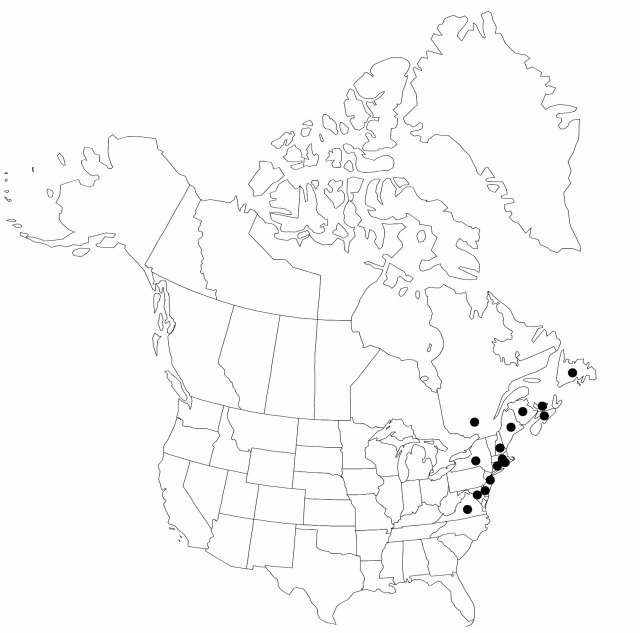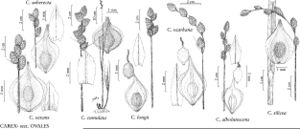Carex silicea
Proc. Amer. Acad. Arts 7: 393. 1868.
Plants densely cespitose. Culms 15–85 cm; vegetative culms inconspicuous. Leaves: sheaths conspicuously green-veined adaxially nearly to collar, narrow hyaline band or sharp Y-shaped region at collar, adaxially firm, summits truncate, prolonged 1–4 mm beyond collar, lateral auricles usually present, finely papillose (30X); distal ligules 1.2–3.5 mm; blades 2–4 per fertile culm, ± whitish green, 10–25 cm × 1–5 mm, stiff. Inflorescences arching or nodding, open, silvery green, (2.5–) 4–8 cm × 5–12 mm; proximal internode 5–22 mm; 2d internode 6–19 mm; proximal bracts scalelike or bristlelike, shorter than inflorescences. Spikes 3–7 (–12), distant, distinct, ellipsoid, (5–) 10–20 × 4–8 mm, bases clavate, apex acute to obtuse; staminate portion of well-developed spikes 2–11 mm. Pistillate scales white-hyaline, with green to gold midstripe, ovate, 4–5.2 mm, as long as and narrower than perigynia, margins frequently involute, apex acute; staminate scales with apex acute. Perigynia appressed, light-brown, conspicuously 6–12-veined abaxially, conspicuously 3–5-veined adaxially, obovate to elliptic, somewhat concavo-convex, 3.5–5 × 2–3.2 mm, 0.5–0.6 mm thick, margin flat, including wing 0.5–0.8 mm wide, somewhat papillose; beak light-brown at tip, flat, ciliate-serrulate, abaxial suture with conspicuous white-hyaline margin, distance from beak tip to achene 1.5–2.5 mm. Achenes elliptic, 1.6–1.8 × 1–1.2 mm, 0.5–0.6 mm thick. 2n = 74, 76.
Phenology: Fruiting early–mid summer.
Habitat: Coastal sand and gravel flats and dunes
Elevation: 0 m
Distribution

N.B., Nfld. and Labr. (Nfld.), N.S., P.E.I., Que., Conn., Del., Maine, Md., Mass., N.H., N.J., N.Y., R.I., Va.
Discussion
Selected References
None.
Lower Taxa
"shortened" is not a number."narrower" is not a number."+timesaslongasinflorescences" is not declared as a valid unit of measurement for this property."not undefined" is not a number.
